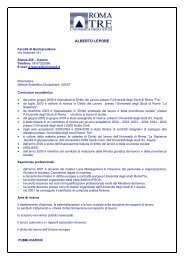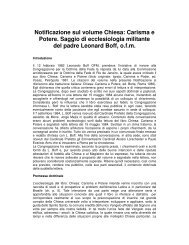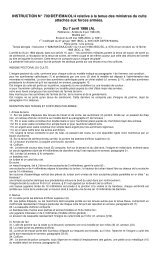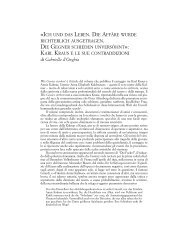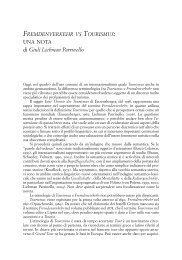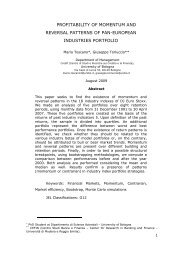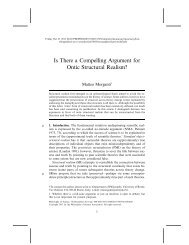Determinants and effects of Venture Capital and Private Equity ...
Determinants and effects of Venture Capital and Private Equity ...
Determinants and effects of Venture Capital and Private Equity ...
Create successful ePaper yourself
Turn your PDF publications into a flip-book with our unique Google optimized e-Paper software.
might be less keen on revealing details <strong>of</strong> his business due to the risk <strong>of</strong> losing his ideas <strong>and</strong> the<br />
related competitive advantages (Ueda, 2004).<br />
Traditionally, banks have always played an important role among all the financial<br />
intermediaries devoted to the support <strong>of</strong> SMEs. However, under the circumstances outlined<br />
above, the business model <strong>of</strong> the traditional bank appears to better meet the needs <strong>of</strong> medium<br />
size firms which have already an established track record <strong>and</strong> operate in traditional sectors.<br />
In fact, the provision <strong>of</strong> debt by a bank to a small business is essentially an agency problem<br />
in which the bank (as principal) is using the firm (as agent) to generate a return on money<br />
advanced. This process occurs under conditions <strong>of</strong> imperfect <strong>and</strong> asymmetric information<br />
(Berger <strong>and</strong> Udell, 1995; Keasey <strong>and</strong> Watson, 1993) which relate both to the ex ante evaluation<br />
<strong>of</strong> the project <strong>and</strong> the entrepreneur (adverse selection) <strong>and</strong> to the ex post monitoring <strong>of</strong><br />
performance (moral hazard). Such information problems are not unique to the small firms<br />
sector, but are considerably more prevalent there because <strong>of</strong> the anticipated higher costs <strong>of</strong><br />
information collection.<br />
Traditionally, there is an agreement on the fact that the degree <strong>of</strong> information asymmetry<br />
may be reduced through two mechanisms: the provision <strong>of</strong> collateral as part <strong>of</strong> the debt<br />
contract <strong>and</strong> the development <strong>of</strong> a close working relationship between the lender <strong>and</strong> the<br />
borrower (Binks <strong>and</strong> Ennew, 1996). Specifically, the low‐risk borrowers who leave the market in<br />
the Stiglitz‐Weiss model (1981) can signal their status by a willingness to <strong>of</strong>fer appropriate<br />
levels <strong>of</strong> collateral; a close relationship has the potential to provide the bank with a better<br />
underst<strong>and</strong>ing <strong>of</strong> the operating environment facing a particular business, a clearer picture <strong>of</strong><br />
the managerial attributes <strong>of</strong> the owner <strong>and</strong> a more accurate overview <strong>of</strong> the prospects for the<br />
business. Stein (2002) stresses this issue showing that local regional banks have superior skills<br />
in acquiring the s<strong>of</strong>t information stemming from the strict contact with small firms active in the<br />
neighbourhood. The less hierarchical <strong>and</strong> rigid modus oper<strong>and</strong>i <strong>of</strong> local banks are the key<br />
elements which allow for the acquisition <strong>of</strong> non‐computable information which is the typical<br />
outcome <strong>of</strong> the relationship lending business model.<br />
Nevertheless, there are intrinsic characteristic <strong>of</strong> SMEs which can hinder the process: on the<br />
one h<strong>and</strong> because <strong>of</strong> the technology‐intensive nature <strong>of</strong> their activity <strong>and</strong> their lack <strong>of</strong> a track<br />
record, they face severe adverse selection <strong>and</strong> moral hazard problems; on the other h<strong>and</strong>, most<br />
<strong>of</strong> their assets are firm‐specific or intangible <strong>and</strong> hence cannot be pledged as collateral. By this<br />
meaning we confirm that the credit rationing is especially acute for some clusters <strong>of</strong> customers:<br />
smaller, younger <strong>and</strong> independent firms report more difficulties than other firms when asking<br />
for bank credit. Moreover, Del Colle, Finaldi Russo <strong>and</strong> Generale (2006) show that small<br />
business are usually affected by multiple lending relationships with banks which can imply a<br />
lower information disclosure. The last outcome points out the weaknesses <strong>of</strong> the relationship<br />
lending model, which sees the unique long‐term nature interaction between firm <strong>and</strong> bank as<br />
the way information asymmetries can be sort out. Further, the study <strong>of</strong> Panetta, Schivardi,<br />
Shum (2004) on the <strong>effects</strong> <strong>of</strong> the concentration <strong>of</strong> the Italian banking industry, suggests that,<br />
- 6 -




